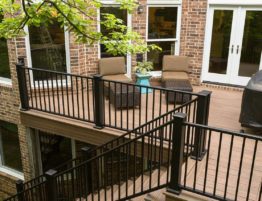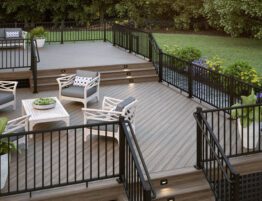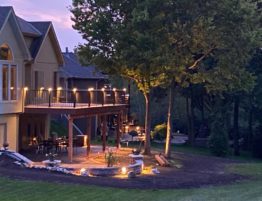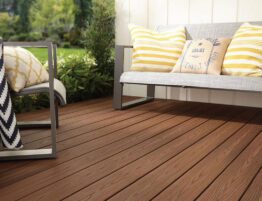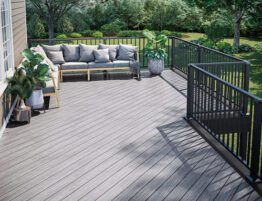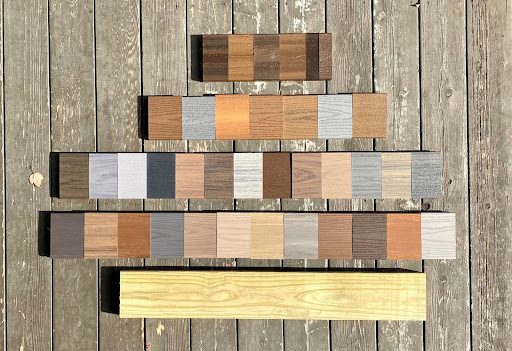
At Creative Concepts and Design, we specialize in building the best decks in the Kansas City area. Many times, our customers ask us, “What is the best material to build a deck?” There are a number of factors to take into consideration when searching for the best decking materials for your new deck. Typically we try to focus on ROI and budget when selecting decking materials. There is no clear cut answer because everyone’s situation is unique.
Choosing the Best Decking Material Depends on How Long You Will Live in Your Home
First you need to establish how long you plan to live in the home. If you plan to live in the home for less than 7 years you are very much like a homebuilder or house flipper. Of course you want to enjoy your prospective deck, but you also have to see it as an investment. If you want to recoup the most money, you will need to create an adequate space for the least amount of money that will still be in reasonable condition when you sell in the years to come.
Deck Material Price Tier
It’s always good to have a basic idea of your choices and the cost of each choice. Here is a general price tier for decking material, from highest cost to lowest:
- Pressure treated
- Composite flooring
- Cedar
- Capped composite
- PVC cellular or stranded
- Tile
- Redwood
- Exotic hardwoods
- Metal/Aluminum
Treated or Composite Decking Gives the Best ROI if You Will Be in Your Home for 7 Years or Less
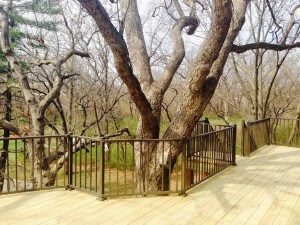 If you plan to live in your home for seven years or less, you should consider treated lumber or composite. Both of these are a builder-grade finish and for good reason. The builder or home flipper will make the best ROI using these decking options. (Creating the space for the least amount of money is the name of their game.) Don’t confuse economical with quality. Just because the deck has a treated floor doesn’t necessarily mean it’s poor quality. A quality deck comes from craftsmanship not finishes.
If you plan to live in your home for seven years or less, you should consider treated lumber or composite. Both of these are a builder-grade finish and for good reason. The builder or home flipper will make the best ROI using these decking options. (Creating the space for the least amount of money is the name of their game.) Don’t confuse economical with quality. Just because the deck has a treated floor doesn’t necessarily mean it’s poor quality. A quality deck comes from craftsmanship not finishes.
Pros of Treated Lumber
Treated lumber is very durable because it has been treated to be resistant to bugs and decay. Treated lumber lasts 20-30 years, so you will get a nice, long life out of it. It can be stained a variety of colors so it will look beautiful. Finally, you can’t beat the price point.
Cons of Treated Lumber
That being said, treated lumber does have some shortcomings and limitations. It shrinks, curls, cracks, cups, and twists! This is a fact, so don’t think it won’t happen to you because it will. If your expectations are clear, you will be reasonably happy with the performance of your deck. The reason treated lumber does all of these hideous things is a result of the treatment process at the mill. Treated lumber is pine that has been put into a pressure chamber. Once the boards go into the pressure chamber, fluid is forced into the wood. This fluid makes it decay resistant and bug resistant. Think of this like the dish sponge that sat on your mothers sink. When it’s wet it is in full shape. When it dries it shrinks and curls. The exact same thing happens with treated lumber when it dries. Treated lumber also “checks”or cracks. This is also caused by changes in moisture content in the board.
A Word of Caution about Manufactured Decking
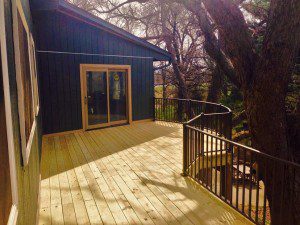 Also, there is a lot of talk floating around out there on the internet pumping the manufactured products. Be careful of the hype. You will read terms like 20-year warranty, maintenance free, limited lifetime warranty, fade resistant, mold resistant…the list goes on forever and millions of marketing dollars are poured into talking manufactured decking up to be the greatest thing since sliced bread. If you drink the Kool-Aid, you’ll be convinced it’s the only way to go. Well, let me let you in on a little secret – 99% of all residential decks are built using treated lumber for the frame. When the frame goes, it all goes. The average shelf life of a treated deck is 20-30 years. It doesn’t matter if your manufactured decking that you paid a pretty penny for lasts longer, you will still have to replace the whole structure. So please drink responsibly. 😉
Also, there is a lot of talk floating around out there on the internet pumping the manufactured products. Be careful of the hype. You will read terms like 20-year warranty, maintenance free, limited lifetime warranty, fade resistant, mold resistant…the list goes on forever and millions of marketing dollars are poured into talking manufactured decking up to be the greatest thing since sliced bread. If you drink the Kool-Aid, you’ll be convinced it’s the only way to go. Well, let me let you in on a little secret – 99% of all residential decks are built using treated lumber for the frame. When the frame goes, it all goes. The average shelf life of a treated deck is 20-30 years. It doesn’t matter if your manufactured decking that you paid a pretty penny for lasts longer, you will still have to replace the whole structure. So please drink responsibly. 😉
Composite Decking Is Best for ROI if You Plan to Be in Your Home 5-10 Years
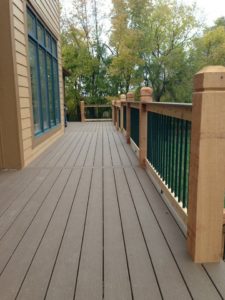 The term “composite” and brand “Trex” have become household names, so let me first explain what composite is. Composite decking is a manmade product made from wood particles and oftentimes recycled plastic.
The term “composite” and brand “Trex” have become household names, so let me first explain what composite is. Composite decking is a manmade product made from wood particles and oftentimes recycled plastic.
Pros of Composite Decking
Composite has a relatively low thermal expansion and contraction rate compared to PVC. It is impermeable to water, and has a life span of 20-30 years. Composite is relatively inexpensive compared to capped composite, and PVC. It makes for a great selection if you plan to live in your home for more than 5 years and less than 10. Once you surpass the 5-year point of ownership, the low maintenance composite starts to offset the premium over treated decking due to the time and materials needed to maintain treated decking. Composite decking typically comes in solid colors. The easiest way to identify composite decking is to look at the top of the board and if you can see the wood particles in the surface you know it’s composite. This is also a great product for anyone looking for low-maintenance decking on a strict budget or fixed income. It allows you the freedom of low to no-maintenance with minimal cost. No staining, no pressure washing, just keep the leaves off it and you are set.
Cons of Composite Decking

Since composite has organic material in the surface it can still get mold and algae. Composite is also porous and can stain. UV exposure will cause it to fade 3-4 shades in the course of its lifetime. The fade curve starts relatively early so you want to make sure and rotate furniture, pots, rugs, and plants. If you damage a deck board or two expect to see a color difference when you replace the damaged decking with the new. Even though this product will last a long time and usually comes with a manufacturer’s warranty, it really starts to show its age around the 7-10 year mark. Since this deck board is manufactured with tight tolerances, any deficiencies in the deck frame will become obvious. For this reason it is not a good idea to resurface an old deck frame with any manufactured decking.
TIP: My favorite manufacturer of composite decking is Evergrain by Envisions Decking. They are a Missouri-based local company that I trust.
Cedar Decking Gives the Best ROI if You Plan to Be in Your Home 10-30 Years
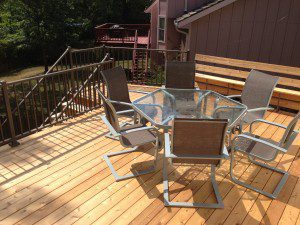
Western red cedar is one of my favorite deck boards! There is just something classy about a well made cedar deck that I love. It has a beautiful golden color that gives off a warm craftsman-style vibe. It even smells good. Personally, I think if you choose to go cedar you need to live in the home for 10-30 years and part of the ROI is the enjoyment of a beautiful natural wood deck.
Cedar Decking
Fun Fact: according to Wikipedia, what we commonly refer to as Western red cedar, “Thuja plicata”, is an evergreen coniferous tree in the cypress family Cupressaceae, native to western North America. It is also called Pacific red cedar, giant arborvitae, western arborvitae, giant cedar, shinglewood, or just cedar. It is not a true cedar of the genus Cedrus.
Pros of Cedar
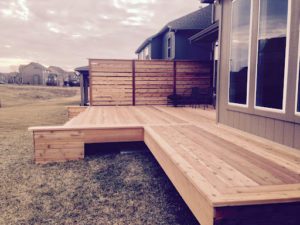 Cedar is kiln-dried. Once it is removed from the kiln, it has a much lower moisture content than pressure treated pine. What does this mean? Cedar doesn’t warp, shrink, and twist nearly as badly as pressure treated wood. I have seen many cedar decks over 30 years old. Due to the polyoxyphenols (oils and acids), cedar is decay resistant and bug resistant.
Cedar is kiln-dried. Once it is removed from the kiln, it has a much lower moisture content than pressure treated pine. What does this mean? Cedar doesn’t warp, shrink, and twist nearly as badly as pressure treated wood. I have seen many cedar decks over 30 years old. Due to the polyoxyphenols (oils and acids), cedar is decay resistant and bug resistant.
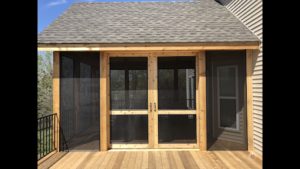
Cons of Cedar
Cedar is soft and can scratch and scar easily. Not a great choice for large dogs that can damage the decking with their nails. Cedar also requires maintenance to be waterproofed and will patina from UV exposure. Cedar is not a great choice if it is ground level, constantly wet, covered by a rug or leaves. Constant moisture or humidity will exponentially increase the decay rate. However, if you keep it high and dry, with routine maintenance it’s a great finish.
TIP: My favorite place to purchase Cedar is Kansas City Deck Supply. They source a higher grade of cedar than can be found at your local lumber yard and box stores such as Home Depot, Lowe’s, or Menards.
Capped Composite Decking Gives the Best ROI if You Plan to Live in Your Home for 10-30 Years
Composite decking is made by mixing plastic and wood fibers and then molding the material into boards. My favorite is capped composite decking. It is, hands down, the best performing product in a 4-season climate. Creative Concepts & Design builds around 100 decks per year.
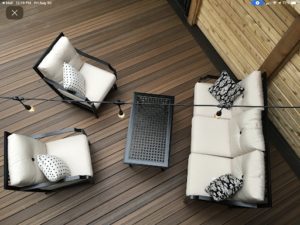

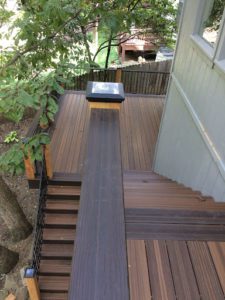 In the last ten years, I have never had a call back on a capped composite deck regarding expansion and contraction issues, mold, fading, or staining. From a business owner’s standpoint, if I sold nothing but capped composite I would be a happy man. If you ask me what I would go with on my own deck or my family’s deck, it would be capped composite decking. Hey YOU! Look no further. Winner winner, chicken dinner! What is capped composite and why am I raving to the gods about it. Well… let me tell you.
In the last ten years, I have never had a call back on a capped composite deck regarding expansion and contraction issues, mold, fading, or staining. From a business owner’s standpoint, if I sold nothing but capped composite I would be a happy man. If you ask me what I would go with on my own deck or my family’s deck, it would be capped composite decking. Hey YOU! Look no further. Winner winner, chicken dinner! What is capped composite and why am I raving to the gods about it. Well… let me tell you.
Pros of Capped Composite
 Capped composite decking has the same core as the traditional composite like Evergrain, however, it also has a PVC cap laminated to 3-4 sides of it. This PVC cap makes it extremely fade resistant, stain resistant, mildew and mold resistant. It also can come with multiple color tones and textures. All that being said, the best part of it is you get all the benefits of the PVC with the low thermal expansion and contraction rate of the composite. If you are looking for the closest thing to set-it-and-forget-it in the Midwest, capped composite is the deck board you are after.
Capped composite decking has the same core as the traditional composite like Evergrain, however, it also has a PVC cap laminated to 3-4 sides of it. This PVC cap makes it extremely fade resistant, stain resistant, mildew and mold resistant. It also can come with multiple color tones and textures. All that being said, the best part of it is you get all the benefits of the PVC with the low thermal expansion and contraction rate of the composite. If you are looking for the closest thing to set-it-and-forget-it in the Midwest, capped composite is the deck board you are after.
Cons of Capped Composite
There really aren’t any cons to speak of, but be aware that not all capped composite is created equal. You want to make sure you go with a reputable manufacturer that has a quality cap. A lot of the box stores are selling capped composite at unbelievably low prices and the cap is soft and scratches easily. You get what you pay for here.
Speaking of getting what you pay for, most of the capped composite decking manufacturers have price tiering. It’s based on color, not quality. Once you are looking at quality manufacturers’ products don’t get caught up in thinking the more expensive price tier is better quality and will last longer because that’s simply not true. They base the pricing on appearance so the more pigment in the board the more it costs. Don’t forget about that ROI. If you choose the most expensive color make sure that extra money spent is strictly for your enjoyment. Also, these companies usually have a value board that is scalloped on the bottom. It’s okay, but if I had my choice I would step up and get a solid board.
TIP: My favorite capped composite decking manufacturers are Envisions and Deckorators. Both manufacturers have a durable capped deck board and solid companies that stand behind their product.
PVC Decking Gives You the Best ROI if You Plan to Live in Your Home for 10-30 Years
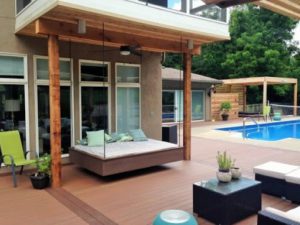 PVC is short for polyvinyl chloride, a common plastic much stronger than vinyl. PVC decking is often perceived as the industry leader. It offers the largest selection of textures and colors.There are two types of PVC decking – cellular and stranded. One unique thing about cellular PVC is that you can heat it up and bend it. Want a curved deck that will make the cover of a magazine? Cellular PVC is the solution. They are beautiful.
PVC is short for polyvinyl chloride, a common plastic much stronger than vinyl. PVC decking is often perceived as the industry leader. It offers the largest selection of textures and colors.There are two types of PVC decking – cellular and stranded. One unique thing about cellular PVC is that you can heat it up and bend it. Want a curved deck that will make the cover of a magazine? Cellular PVC is the solution. They are beautiful.
Pros of PVC Decking
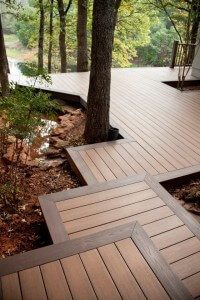 PVC decking is low maintenance and long-lasting. Because PVC deck boards contain plastic and synthetic materials only, they won’t promote mold growth and are moisture resistant and resistant to fading. And because they’re not made with any organic materials, PVC deck boards resist insect infestation as well. They require no painting or staining. As a bonus for the environment, they are often manufactured from recycled materials.
PVC decking is low maintenance and long-lasting. Because PVC deck boards contain plastic and synthetic materials only, they won’t promote mold growth and are moisture resistant and resistant to fading. And because they’re not made with any organic materials, PVC deck boards resist insect infestation as well. They require no painting or staining. As a bonus for the environment, they are often manufactured from recycled materials.
Cons of PVC Decking
 Some people do not like the look as much as natural wood. Also, materials such as rubber may cause discoloration when they come in contact with the decking. Additionally, cellular PVC has a ridiculous thermal expansion and contraction rate. This means that when it’s hot outside the decking grows. When it’s cold outside, the decking shrinks. This can result in broken screws and gapping that does not meet expectations for the price point. If you have a small deck, no big deal. If you have a large deck and live in Kansas City, you will be disappointed. In all fairness Deckorators have attempted to cut down on the expansion issues by using stranded PVC. It still expands and contracts but it’s much better than the cellular decking on the market today.
Some people do not like the look as much as natural wood. Also, materials such as rubber may cause discoloration when they come in contact with the decking. Additionally, cellular PVC has a ridiculous thermal expansion and contraction rate. This means that when it’s hot outside the decking grows. When it’s cold outside, the decking shrinks. This can result in broken screws and gapping that does not meet expectations for the price point. If you have a small deck, no big deal. If you have a large deck and live in Kansas City, you will be disappointed. In all fairness Deckorators have attempted to cut down on the expansion issues by using stranded PVC. It still expands and contracts but it’s much better than the cellular decking on the market today.
TIP: PVC decking manufacturers I recommend are AZEK and Deckorators
Other Decking Worth Mentioning
We’ve covered the most popular decking materials including pressure treated, composite, cedar, capped composite and PVC decking. There are a few others that are worth mentioning. Here are some options to consider if you want to break out of the traditional and do something unique.
Tile Decking
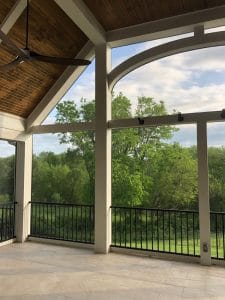
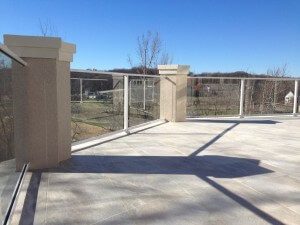

Tile decks are a different animal and you need to do your research before selecting a contractor. If you are considering a tile deck it would be wise to take a look at previous projects. There are many contractors and homebuilders who try to install a tile deck using the same methods as a shower installation. This is a very bad idea because those materials have not been engineered to handle the expansion and contraction that takes place in an outdoor environment.
Cons of Tile Decks
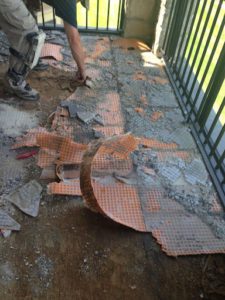

Cost, complexity, and maintenance are all concerns with tile decks. They are expensive, and they require monitoring in spring and fall for grout cracks. At some point the grout will need to be refinished. Temperature and humidity can wreak havoc on a tile deck. From my experience, a tile deck using a plastic or rubber membrane is destined to fail. Use a contractor with experience building a tile deck, or you will be in for trouble.
Pros of Tile Decks
 Tile decks are unique and beautiful, elegant, and sophisticated. A well-executed tile deck can be absolutely stunning and last for many years. Another benefit to tile decks is they shed water. This allows the area below the deck to be a dry space. It also protects the deck frame from rain and will last much longer.
Tile decks are unique and beautiful, elegant, and sophisticated. A well-executed tile deck can be absolutely stunning and last for many years. Another benefit to tile decks is they shed water. This allows the area below the deck to be a dry space. It also protects the deck frame from rain and will last much longer.
Creative Concepts & Design has been installing tile decks for nearly a decade with success. We only use one exclusive subfloor engineered specifically for tile decks that has a 10-year manufacturer warranty. The deck subfloor has the same expansion and contraction rate as the porcelain tile installed on top of it. We also use one experienced tile installer exclusively. The reason being, a tile deck costs a premium and we take every measure possible to never have to replace one that failed. We have seen many poorly installed, failed tile decks on multi-million dollar homes and fortunately, ours have withstood the test of time.
Metal Decking
Aluminum decking is relatively new to the market and not prolific in the Kansas City area. However, that doesn’t mean it isn’t interesting and worth looking into.
Pros of Metal decking
Some of the benefits to aluminum decking are it retains less heat and will practically last forever. It would probably make the most sense in an industrial setting or if you wanted a very modern, clean, space with minimalist design.
Cons of Metal Decking
Material & labor costs are expensive. There are few color & texture options. Metal lacks the warm craftsmen feel that wood and composite provide. The coating on the aluminum has not been time tested. It can be noisy and conducts electricity.
Redwood Decking
Redwood decking is very popular in the western states. However, due to the demand on the west coast and limited resources, redwood can be expensive and difficult to source here. I love redwood decks but they come at a premium in Kansas City.
Pros of Redwood Decking
Redwood decking is absolutely gorgeous and extremely durable. A redwood deck will last for decades.
Cons of Redwood Decking
Local distribution centers in Kansas City do not stock redwood so when we build a redwood deck we must have it trucked in from California raising the price. This also means that there are no returns and the lumber has been culled. This makes it difficult to know what quality of lumber will arrive on the truck.
Exotic Hardwood Decking (Ipe)
There are many exotic hardwoods on the market that can be sourced by local distribution here in the Kansas City area. Ipe, also known as Brazilian Walnut, is probably the most popular. You would be hard pressed to find a manufactured deck board on the market that can match the sophistication of exotic hardwood decking.
Pros of Ipe
Ipe is extremely durable, rot resistant, decay resistant and can withstand just about anything mother nature throws at it. The wood is extremely dense and contains natural oils that preserve it. You can expect an ipe deck or fence to last up to 50 years without replacement. With oil treatment, its lifespan can be up to 75 years. Another interesting benefit of Ipe is that while it does gain some warmth when the sun is out, it does not retain the heat, so it’s never too hot to walk on.
Cons of Ipe
Ipe is more expensive than other types of wood. Because it is so dense, it is difficult and time consuming to install. Holes must be pre-drilled and the wood is hard on saw blades. These factors increase labor costs. The sawdust is extremely fine as well and can cause respiratory problems when inhaled. Ipe also tends to darken over time. There are some concerns about over-harvesting so look for the Forest Stewardship Council (FSC-certified wood) label.
Well, that was a lot of information. I hope it comes in handy when deciding what kind of decking to put on your deck. Personally, I think anything more expensive than treated or composite decking warrants 10+ years in the house before you sell. But that’s just my opinion. We’d love to help you create the backyard of your dreams.


